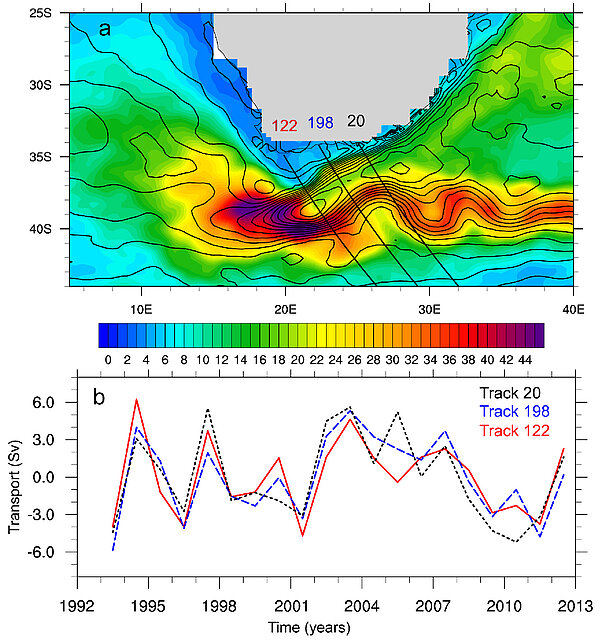The Agulhas current leaks
Image of the Month - August 2014

Waters from the Indian Ocean, carried by the Agulhas Current separate from it when it turns sharply back East, becoming the Agulhas Return Current. The volume of the water exchanges between Indian and Atlantic Ocean is linked to this "leakage" of relatively warm and salty water separating from the Agulhas Current. However, discriminating between the different flows of currents South of Africa is quite difficult, especially when you want only the waters from the Indian Ocean to be taken into account. A new study proposes to measure the "leakage" indirectly by looking at the difference in volume transport between the Agulhas Current and its return current. Several T/P-Jason-1-Jason-2 tracks cross at right angle both the Agulhas Current and its Return. These can be used to estimate the difference between both flows.
Using this technique, and twenty years of altimetry data, the evolution of the Agulhas leakage, and thus of the water exchanges between Indian and Atlantic Ocean has been computed. Studying the impact of their variability on the climate is the next step.
See also:
- Data: Ssalto/Duacs near-real and delayed time multimission altimeter products
- Applications: mesoscale ocean circulation
- Applications: Agulhas rings
- Image of the Month, September 2010: ASAR vs altimetry South of Africa
- Image of the Month, October 2012: Accelerated eddy shedding
- Image of the Month, July 2000: Where currents meet
Other websites on this subject:
References
- Le Bars, D., Durgadoo, J. V., Dijkstra, H. A., Biastoch, A., and De Ruijter, W. P. M.: An observed 20-year time series of Agulhas leakage, Ocean Sci., 10, 601-609, doi:10.5194/os-10-601-2014, 2014.
- Le Bars, D., Dynamics and estimation of the Agulhas leakage, PhD dissertation, 2014




